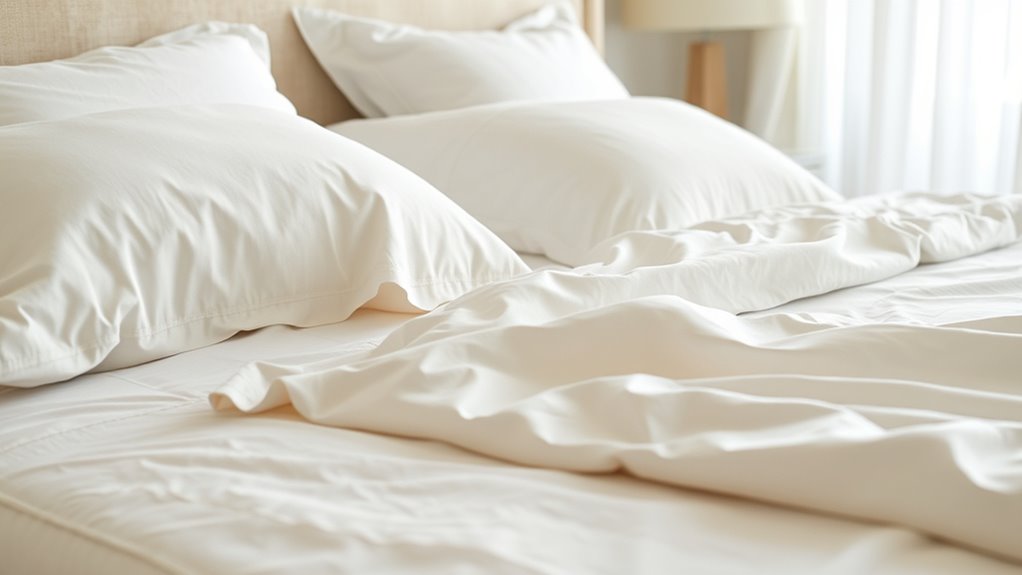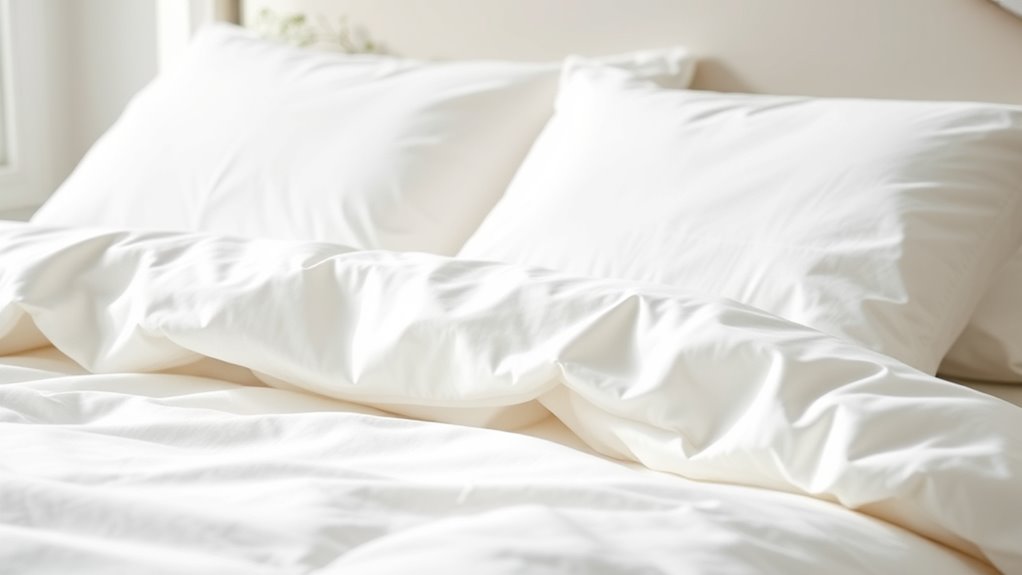To create allergen-free bedding, choose natural fabrics like organic cotton or bamboo that are breathable and hypoallergenic, or opt for durable synthetic materials like polyester. Use protective mattress and pillow encasements, wash bedding weekly in hot water, and avoid harsh chemicals. Keep your bedroom clean and free of dust, pet dander, and mold. Certified products with allergen-free labels guarantee safety. If you want to learn more, you’ll discover practical tips for lasting allergy relief and better sleep.
Key Takeaways
- Choose bedding made from natural, hypoallergenic fabrics like organic cotton or bamboo, and ensure they are dyed with non-toxic, hypoallergenic dyes.
- Use allergen-proof mattress and pillow encasements that are breathable, waterproof, and tightly woven to block dust mites and pet dander.
- Wash bedding weekly at 130°F (54°C) with allergen-removing detergents to eliminate dust mites, bacteria, and pet dander effectively.
- Regularly vacuum and dust your sleeping environment with HEPA filters, and keep pets out of the bedroom to reduce allergens.
- Select products certified by reputable organizations (e.g., OEKO-TEX, GOTS) with allergen-free labels for safety and effectiveness.
Choosing the Right Natural and Synthetic Fabrics

When selecting allergen-free bedding, it’s important to understand the differences between natural and synthetic fabrics. Natural fabrics like organic cotton or bamboo are known for their breathability and softness, but check their fabric durability to guarantee they withstand regular washing. Synthetic options, such as polyester or microfiber, often offer greater durability and resistance to wear and tear. Additionally, dye safety is vital; look for bedding dyed with non-toxic, hypoallergenic dyes to prevent skin irritation. Natural fabrics may require gentle dyes, while synthetic fabrics can often hold vibrant colors longer without fading. By considering both fabric durability and dye safety, you ensure your bedding remains safe, comfortable, and long-lasting, reducing allergen buildup and promoting better sleep. Incorporating emotional alignment techniques can help reinforce your commitment to creating a healthy sleep environment.
The Benefits of Hypoallergenic Bedding Materials

Hypoallergenic bedding can help reduce allergy symptoms and make it easier for you to breathe at night. It also improves your sleep quality by creating a cleaner, irritation-free environment. Plus, these materials can promote healthier skin by minimizing irritation and dryness.
Reduces Allergy Symptoms
Using hypoallergenic bedding materials can substantially reduce allergy symptoms, making your nights more comfortable. These materials help prevent common triggers like dust mites and pet dander from accumulating in your bedding. Hypoallergenic fabrics create a barrier that discourages dust mites, which are a major allergen, and aid in pet allergen control by reducing the amount of dander that settles on your sheets and pillowcases. Additionally, they often feature antimicrobial properties that inhibit mold and bacteria growth, further lowering allergy risks. With consistent use, you’ll notice fewer sneezing fits, less congestion, and reduced eye irritation. By choosing hypoallergenic bedding, you actively improve your indoor environment, helping you breathe easier and enjoy restful sleep without the discomfort caused by allergens. Understanding allergen control is key to maximizing the benefits of hypoallergenic bedding.
Enhances Sleep Quality
Because hypoallergenic bedding materials are designed to minimize allergens, they create a cleaner and more comfortable sleeping environment, which directly boosts sleep quality. When your sleep environment is free from irritants, you’re less likely to wake up feeling restless or achy. Bedding customization allows you to choose materials that suit your preferences, ensuring ideal comfort. For example, breathable fabrics like hypoallergenic cotton or bamboo help regulate temperature and reduce sweating, promoting deeper rest. By selecting hypoallergenic pillows, sheets, and comforters, you eliminate common sources of allergens that can disrupt sleep. This tailored approach helps you fall asleep faster and enjoy uninterrupted rest throughout the night. Additionally, incorporating essential oils for sleep into your bedtime routine can further enhance relaxation and overall sleep quality. Ultimately, enhancing your sleep environment with allergen-free bedding supports restorative sleep and overall well-being.
Promotes Skin Health
Since your skin is in direct contact with your bedding every night, choosing hypoallergenic materials can markedly benefit your skin health. These fabrics are often free from harsh chemicals used in fabric dyeing, reducing irritation and allergic reactions. Hypoallergenic bedding also undergoes allergy testing to ensure it’s safe for sensitive skin. This testing helps identify materials that are less likely to cause allergic reactions, further ensuring comfort and safety. This minimizes the risk of breakouts, redness, and inflammation caused by allergens or irritants. When selecting bedding, look for options with natural, non-toxic finishes that support skin health. Additionally, hypoallergenic materials breathe better, preventing excess moisture that can lead to skin issues. By prioritizing these features, you create a barrier against irritants and promote healthier, clearer skin over time.
How to Properly Wash and Maintain Your Bedding

To keep your bedding allergen-free, it is crucial to wash it correctly and follow proper care tips. Using the right temperature helps eliminate dust mites and bacteria, while gentle handling preserves the fabric’s hypoallergenic qualities. Proper understanding of soulmate angel numbers can guide you in selecting the best routines for maintaining your bedding’s cleanliness and energetic harmony. Next, we’ll explore how to set your washer and maintain your bedding for maximum cleanliness.
Washing Temperature Tips
Washing your allergen-free bedding at the right temperature is essential for maintaining its cleanliness and effectiveness. Using the correct temperature helps eradicate allergens without damaging the fabric. Generally, washing at 130°F (54°C) kills dust mites and bacteria while preserving fabric durability. Lower temperatures may not fully remove allergens, but high temperatures can weaken delicate fibers. Always check your bedding’s care label to choose the proper setting. To optimize cleaning, use a suitable washing detergent formulated for allergen removal. Keep in mind:
- Hot water (130°F/54°C) is most effective for allergen elimination
- Avoid exceeding recommended temperatures to prevent fabric damage
- Use a gentle cycle to prolong fabric lifespan
In addition, selecting appropriate washing settings can help ensure thorough allergen removal while protecting your bedding’s integrity. Balancing temperature with your bedding’s care instructions ensures thorough cleaning without compromising quality.
Proper Bedding Care
Proper bedding care involves following specific washing and maintenance routines to keep your allergen-free bedding in ideal condition. Use gentle, allergen-reducing detergents and wash at recommended temperatures to eliminate dust mites and allergens effectively. Avoid harsh fabric dyeing processes that can weaken fibers, which may compromise your bedding’s durability and aesthetic appeal. Regularly inspect your bedding for signs of wear to maintain its bedding aesthetics and ensure it remains inviting. When drying, opt for low heat settings to prevent fiber damage and preserve fabric dyeing integrity. Proper storage also matters—keep your bedding in a cool, dry place to prevent mold and dust accumulation. Additionally, fabric dyeing can impact the longevity of your bedding, so choosing products with colorfast dyes helps maintain its appearance over time. Consistent care not only prolongs the lifespan of your bedding but also supports a healthier sleeping environment.
The Importance of Mattress and Pillow Encasements

Encasements for mattresses and pillows play a crucial role in allergy prevention by creating a barrier that blocks dust mites, pet dander, and other allergens from penetrating your bedding. Using effective mattress protection and pillow covers keeps allergens out of reach, reducing allergy symptoms and improving sleep quality. When selecting encasements, look for those that are breathable, waterproof, and tightly woven to ensure maximum effectiveness. These features help prevent allergens from slipping through gaps or accumulating underneath. Regularly washing your encasements is essential to maintain their protective qualities. Additionally, choosing encasements made with specialized fabrics can enhance allergen barrier performance. Remember, well-fitted mattress protection and pillow covers are your first line of defense against allergens, making your sleep environment safer and more comfortable.
Tips for Reducing Dust and Allergens in Your Bedroom

To effectively reduce dust and allergens in your bedroom, start by regularly dusting surfaces with a damp cloth to trap particles rather than spreading them into the air. This simple step helps minimize dust mites and pet dander buildup on furniture and shelves. Wash your bedding weekly in hot water to eliminate dust mites and remove pet dander that accumulates over time. Keep pets out of the bedroom whenever possible to reduce dander exposure. Use a high-efficiency particulate air (HEPA) filter in your room to capture airborne allergens. Vacuum carpets and rugs frequently with a HEPA vacuum cleaner. Declutter your space by reducing unnecessary items that collect dust, making cleaning easier and more effective. Regularly inspecting and replacing your bedding and filters can further enhance your allergen control efforts, creating a cleaner, healthier environment for allergy relief.
Recognizing and Avoiding Common Allergen Triggers

Understanding common allergen triggers is key to managing allergies effectively. Pollen allergies and pet dander are frequent culprits that can worsen symptoms. To minimize exposure, stay aware of potential triggers in your environment. A natural language processing system can help analyze your symptoms and suggest personalized avoidance strategies. Be cautious of:
Managing allergies involves recognizing common triggers like pollen and pet dander to reduce symptoms effectively.
- Keeping windows closed during high pollen seasons
- Regularly grooming and bathing pets to reduce dander
- Avoiding smoking or strong perfumes that can irritate allergies
You should also identify other triggers like dust mites or mold, which can be hidden in bedding or curtains. By recognizing these triggers early, you can take steps to avoid them. Simple changes in your environment and daily habits can considerably improve your allergy symptoms and create a healthier, more comfortable sleeping space.
Shopping Tips for Finding Certified Allergen-Free Products

When shopping for allergen-free bedding, it’s important to look for products that are certified by reputable organizations. Fabric certifications guarantee the bedding meets strict standards for allergen reduction, giving you confidence that it is truly safe. Always check for allergen free labels on packaging; these labels indicate the product has been tested and verified for allergens like dust mites, mold, and pet dander. Focus on certifications from trusted sources such as OEKO-TEX or GOTS, which specify the absence of harmful chemicals and allergens. Avoid products without clear labeling or certification, as they may not guarantee allergen safety. By paying attention to fabric certifications and allergen free labels, you can make informed choices that support a healthier, allergen-free sleeping environment.
Frequently Asked Questions
Are Organic Bedding Options More Allergen-Free Than Synthetic Ones?
You might wonder if organic bedding options are more allergen-free than synthetic ones. Organic benefits include fewer chemical treatments and natural materials that reduce allergic reactions. In contrast, synthetic drawbacks involve chemicals and dyes that can trigger sensitivities. Choosing organic bedding can help you avoid irritants and allergens found in synthetic fabrics, making it a better choice for sensitive skin and allergy sufferers.
Can Allergy-Proof Bedding Help With Non-Allergic Respiratory Issues?
Allergy-proof bedding can definitely help with non-allergic respiratory issues. By reducing dust mites and preventing mold growth, it creates a cleaner sleeping environment. You’ll notice less irritation and better breathing, especially if you’re sensitive to these allergens. Regularly washing and choosing materials designed for allergen reduction can make a big difference in improving your respiratory health and giving you a more restful night’s sleep.
How Often Should I Replace My Hypoallergenic Bedding for Optimal Safety?
You should replace your hypoallergenic bedding based on the bedding replacement frequency recommended by the manufacturer, usually every 1-2 years. This practice guarantees you’re maintaining ideal bedding lifespan and reducing allergen buildup. Regular replacement helps prevent dust mites and mold from accumulating, which can compromise your safety and comfort. Keep an eye on signs of wear or odors, and don’t wait too long to refresh your bedding for ongoing protection.
Are There Specific Certifications to Look for When Buying Allergen-Free Bedding?
Coincidentally, when buying allergen-free bedding, you should look for certifications to verify its safety. These certifications ensure the product meets strict labeling standards, giving you confidence in its hypoallergenic claims. Always check for reputable seals from organizations like OEKO-TEX or GOTS. By focusing on these certifications, you can make smarter choices, guaranteeing your bedding truly helps reduce allergens and improves your sleep quality.
Do Allergen-Free Bedding Materials Affect Sleep Temperature or Comfort?
You might wonder if allergen-free bedding impacts your sleep comfort. Generally, these materials are designed with breathability concerns and temperature regulation in mind, ensuring you stay comfortable throughout the night. High-quality allergen-free fabrics often promote airflow, preventing overheating and moisture buildup. So, if you choose wisely, allergen-free bedding can enhance your sleep experience without sacrificing comfort or temperature control, helping you wake refreshed and allergy-free.
Conclusion
By choosing allergen-free bedding, you’re creating a healthier sleep environment. Did you know that over 50 million Americans suffer from allergies, often worsened by bedding? With the right fabrics, regular washing, and protective encasements, you can reduce allergens and breathe easier. Take control of your sleep space today, and enjoy nights free from sneezing and congestion. Creating an allergen-free bedroom isn’t just a choice—it’s a step toward better health and restful nights.









